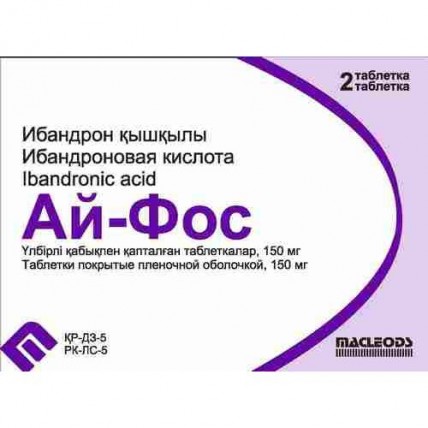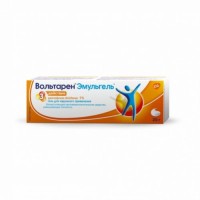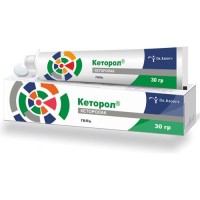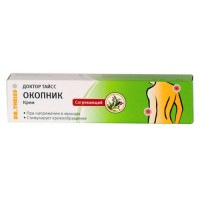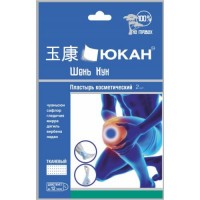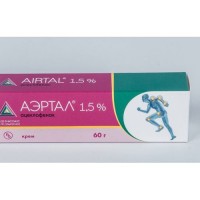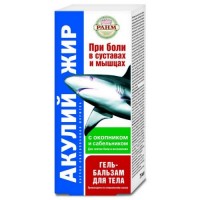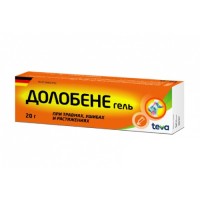Ai-Fos 2's 150 mg film-coated tablets
- $49.90
The instruction for medical use of medicine Ah-Fos the Trade name Ah-Fos the International unlicensed name Ibandronovaya acid the Dosage form of the Tablet film coated, 150 mg Structure One tablet contains active agent - the ibandronat of sodium of monohydrate of 160.33 mg (it is equivalent to ibandronovy acid) (150.00 mg), excipients: lactoses monohydrate, krospovidon (type A), povidone (PVP K-25), silicon dioxide colloidal anhydrous, cellulose microcrystalline (PH 101), cellulose microcrystalline (PH 102), magnesium stearate, Instacoat White (A05G10010) ** ** Structure of Instacoat White (A05G10010) as a percentage: HP2910/gipromelloza 6cPs – 65.0%, % polyethyleneglycol 400 6.00, polyethyleneglycol of 6000 - 6.00%, talc – 5.00%, the titan dioxide (E171) – 18.00%. The description of the Tablet of white or almost white color, oblong shape, biconvex, film coated, with an engraving L 71 on one party and equal on the other hand. Pharmacotherapeutic group Drugs for treatment of a disease of bones. The drugs affecting structure and a mineralization of bones. Bisfosfonata. Ibandronovy acid the ATX M05BA06 Code the Pharmacological Pharmacokinetics Not properties it is revealed direct dependence of efficiency of ibandronovy acid on concentration of substance in blood plasma. Absorption After oral administration ibandronovy acid is quickly soaked up in upper parts of digestive tract. Concentration in blood plasma linearly increases at increase in a dose up to 50 mg and much more - at further increase in a dose. The maximum concentration is reached in 0.5-2 h (a median – 1 h) after reception on an empty stomach, absolute bioavailability of 0.6%. The concomitant use of food or drinks (except plain water) reduces bioavailability of ibandronovy acid by 90%. At intake of ibandronovy acid in 60 min. prior to food of significant decrease in bioavailability it is not observed. Meal or liquids less than in 60 min. after intake of ibandronovy acid reduces its bioavailability and the caused increase in the mineral density of a bone (MDB). Distribution After hit in a system blood stream ibandronovy acid quickly communicates in a bone tissue or is removed with urine. About 40-50% of amount of the drug circulating in blood well get into a bone tissue and collects in it. The seeming final volume of distribution of 90 l. Communication with proteins of blood plasma of 85%. Metabolism does not exist data on metabolism of ibandronovy acid. Removal the Absorbed fraction of ibandronovy acid is brought out of the circulator course by means of bone absorption (women have about 40-50% in a postmenopause), and the rest is removed in not changed look by kidneys. The part of drug which did not get to blood is removed in not changed view with a stake. Observed final elimination half-life for a tablet of 150 mg of ibandronovy acid at oral introduction at healthy women in a postmenopause makes from 37 to 157 h. Concentration of drug in blood decreases quickly and makes 10% of maximum for 3 and 8 h after intravenous and oral administration respectively. The general clearance of ibandronovy acid is low and is 84–160 ml/min. The renal clearance (healthy women have about 60 ml/min. in a postmenopause) is 50–60% of the general clearance and is connected with clearance of creatinine. The difference between the seeming general and renal clearance reflects digestion of substance a bone tissue. Pharmakokinetika at special groups of patients Paul Pharmakokinetika of ibandronovy acid does not depend on a floor. Race clinically significant interracial distinctions of distribution of ibandronovy acid at representatives of Caucasian and Asian race are not revealed. Rather African race of data is not enough. Patients with a renal failure At patients with a renal failure the renal clearance of ibandronovy acid linearly depends on the clearance of creatinine (CC). For patients with a renal failure easy or moderate severity (KK of ≥30 ml/min.) of dose adjustment is not required. At the patients with a heavy renal failure (KK & lt, 30 ml/min.) receiving drug in a dose of 10 mg orally within 21 days, concentration of ibandronovy acid in blood plasma is 2-3 times higher, than at people with normal function of kidneys. In a heavy renal failure the general clearance of ibandronovy acid decreases to 44 ml/min. However increase in system concentration does not worsen tolerance of drug. Patients with a liver failure Data on pharmacokinetics of ibandronovy acid at patients with an abnormal liver function are absent. The liver does not play an essential role in clearance of ibandronovy acid which is not metabolized, and is removed through kidneys and by assimilation by a bone tissue. Therefore for patients with an abnormal liver function of dose adjustment it is not required. Patients of advanced age the Studied pharmacokinetic parameters do not depend on age. It is necessary to consider possible depression of function of kidneys at elderly patients (see above the section Patients with a Renal Failure). Pediatric population Data on use Ah-Fos for persons under 18 are absent. The pharmacodynamics the action Mechanism Ah-Fos – highly active nitrogen-containing bisfosfonat, specifically inhibits activity of osteoclasts, without affecting their quantity. Ibandronovy acid reduces a resorption of a bone tissue, but has no direct impact on forming of a bone. At women in a postmenopause it reduces the speed of destruction of a bone tissue to the level of reproductive age that leads to the progressing increase in mass of a bone tissue. In experimental models on animals is confirmed by decrease in level of biochemical markers of a bone resorption both in blood plasma, and in urine (a deoksipiridinolin and cross sewed C- and N-telopeptidov of collagen I of type), increase in mineral density of fabric (MPK) and decrease in frequency of changes. The Mineral Density of a Bone (MDB) Administration of drug Ah-Fos of 150 mg once a month within a year increases average MPK of lumbar vertebrae, hips, necks of a hip and a spit by 4.9%, 3.1%, 2.2% and 4.6%. Irrespective of duration of a menopause and from extent of initial loss of mass of bones, drug use Ah-Fos leads to authentically more significant change MPK, than placebo. Within a year the increase in MPK of lumbar vertebrae is observed at 84.0% of patients. Biochemical markers of a bone resorption Clinically significant decrease in serumal concentration of C-trailer peptide is received in 3, 6, 12 and 24 months of therapy. In a year of therapy by drug Ah-Fos of 150 mg average relative change in comparison with initial level was 76%. Decrease in a C-terminal telopeptid more than 50% in comparison with a reference value is noted at 83.5% of the patients receiving drug Ah-Fos of 150 mg of 1 times in 30 days. Indications Treatment of post-menopausal osteoporosis at women for the purpose of prevention of changes. A route of administration and doses Inside, 150 mg (1 tablet) once a month (it is desirable in the same day of every month), in 60 min. prior to the first in this day meal, liquid (except water) or other medicines and nutritional supplements. Tablets Ah-Fos should be swallowed entirely, washing down with a glass (180–240 ml) of clear water in a sitting position or standing and not to lay down within 60 min. after reception. Tablets cannot be chewed or rassasyvat because of a possible ulceration of upper parts of digestive tract. It is impossible to use mineral waters which contain a lot of calcium. It is necessary to receive additional calcium and/or vitamin if their consumption with food insufficient. In case of the admission of planned reception it is necessary to take one pill of drug Ah-Fos of 150 mg if before the planned reception it is more than 7 days, and further to take drug Ah-Fos1 of times a month according to the established schedule. If before the following planned reception less than 7 days, it is necessary to wait to the following according to the plan of reception, and further to continue reception according to the established schedule. It is impossible to take more than 1 pill of drug Ah-Fos in a week. At clearance of creatinine & lt, 30 ml/min. the decision on use Ah-Fos has to be based on individual assessment of a ratio risk advantage for the specific patient. Safety and efficiency at persons & lt, 18 years are not established. Side effects often (≥1/100 to & lt, 1/10) - a headache - an esophagitis, gastritis, a gastroesophageal reflux, dyspepsia, nausea, an abdominal pain, diarrhea - skin rash - a rash - an arthralgia, myalgia, skeletal and muscular pain, a muscular spasm, skeletal and muscular rigidity - a grippopodobny syndrome infrequently (≥1/1000 to & lt, 1/100) - dizziness - a dysphagy, vomiting, an esophagitis, gullet ulcerations, an ulcer or a stricture of a gullet, vomiting, a meteorism - back pains - fatigue - exacerbation of asthma is rare (≥1/10000 to & lt, 1/1000) - hypersensitivity - eye inflammation (uveitis, an episcleritis and a sclerite) - a duodenitis - a Quincke's disease, a face edema, a small tortoiseshell - atypical subtrochanterian and diaphyseal fractures of a femur is very rare (≥1/100000 to & lt, 1/10000) - a jaw osteonecrosis, an osteonecrosis of external acoustical pass - anaphylactic reactions (acute anaphylaxis) - Stephens's syndrome — Johnson, a multiformny erythema of the Contraindication - hypersensitivity to ibandronovy acid or other components of drug - a hypocalcemia - gullet diseases in which the food passage (gullet strictures, an achalasia) - pregnancy and the period of a lactation is broken - the impossibility of the patient is in vertical position standing or sitting within 60 min. after reception of a tablet With care a heavy renal failure (clearance of creatinine & lt, 30 ml/min.). Medicinal interactions Products, calciferous, including milk and firm food, nutritional supplements, antacids and drugs, calciferous and other polyvalent cations (for example, aluminum, magnesium, iron), can break drug absorption. Therefore patients should not take other oral medicines during the period equal to at least 6 hours before intake of ibandronovy acid and within 1 hour after reception Ah-Fos. Bisfosfonaty, acetylsalicylic acid and non-steroidal anti-inflammatory drugs (NPVP) can cause irritation mucous the digestive tract (DT). It is necessary to show extra care at use of NPVP along with drug Ah-Fos. Ranitidine in/in increases bioavailability of ibandronovy acid by 20%. Dose adjustment of ibandronovy acid at simultaneous use with the blockers of H2-histamine receptors or other drugs increasing rn in a stomach is not required. Ibandronovy acid does not affect activity of the main isoenzymes of a system of P450 cytochrome. There is no potential for interaction with tamoxifen or gormonozamenitelny therapy (is oestrogenic). At patients with a multiple myeloma the interaction at simultaneous introduction with Melphalanum/Prednisolonum is noted. In therapeutic concentration ibandronovy acid poorly contacts proteins of blood plasma and therefore, it is improbable that it will force out from binding sites with proteins other medicines. Ibandronovy acid is removed only through kidneys and is not exposed to any biotransformation. The way of removal of ibandronovy acid does not include any transport systems participating in removal of other drugs. Special instructions of Gipokaltsemiya Prior to drug use Ah-Fos it is necessary to skorrigirovat a hypocalcemia and other disturbances of metabolism of a bone tissue and a mineral metabolism. Patients should use enough calcium and vitamin D. Disturbances from digestive tract Orally entered bisfosfonata can cause local irritation mucous upper parts of a GIT. Due to these possible irritating effects and potential for deterioration in a basic disease, the care should be shown when prescribing ibandronovy acid to patients with the available disturbances in upper parts of a GIT (for example, the known syndrome of Barret, a dysphagy, other diseases of a gullet, gastritis, a duodenitis or ulcers). Due to the possible irritating effects and risk for deterioration in a basic disease, the care should be shown when prescribing ibandronovy acid to patients with the available disturbances in upper parts of a GIT (for example, the known syndrome of Barret, a dysphagy, other diseases of a gullet, gastritis, a duodenitis or ulcers). These listed diseases which have to be taken into account when assigning Ah-Fos. The attending physician has to examine the patient regarding identification of symptoms of damage of a gullet. In turn patients at emergence or strengthening of disturbance of swallowing, an odinofagiya (feeling of pain when passing food on a gullet), pains during the swallowing, pain behind a breast, heartburn have to stop reception Ah-Fos and see a doctor. The risk of manifestation of heavy adverse effects from a gullet increases at the patients who are not observing recommendations about dosing of medicine or continuing to accept orally bisfosfonata even after emergence of symptoms of irritation of a gullet. Patients have to pay special attention to recommendations about dosing and observe their Passing grippopodobny syndrome, easy or moderately severe which development is possible at intravenous administration of the first dose Ah-Fos usually lasts not for long and passes during treatment, without demanding medical intervention. Increase in frequency of undesirable effects from upper parts of a GIT at patients with gastrointestinal diseases is noted (including a round ulcer without bleeding and hospitalization, dyspepsia or a reflux disease). The jaw osteonecrosis the Osteonecrosis of a jaw (ONCh) in most cases developed at patients with malignant new growths which were exposed to dental procedures, but sometimes occurred in the patients receiving treatment concerning post-menopausal osteoporosis or other diseases. Risk factors of ONCh consider the malignant new growths corresponding to them treatment methods (radiation therapy, radiotheraphy, corticosteroids), associated diseases (anemia, a coagulopathy, infections, smoking, the existing dental diseases, insufficient hygiene of an oral cavity). Patients with risk factors should have examination of the stomatologist and to carry out necessary procedures prior to treatment of a bisfosfonatama. Throughout treatment of a bisfosfonatama such patients should avoid invasive dental procedures. If the osteonecrosis of a jaw developed against the background of treatment of a bisfosfonatama, surgical intervention on a jaw can aggravate a state. There are no data that cancellation of bisfosfonat at the patients needing dental procedures reduces risk of ONCh. In turn, dental operation can aggravate ONCh which developed against the background of reception of bisfosfonat. Therefore the clinical decision on continuation or the termination of reception of bisfosfonat is accepted individually, after assessment of risk and advantage. Atypical fractures of a femur. It was reported about atypical subtrochanterian and diaphyseal changes at treatment of a bisfosfonatama, generally at patients with long therapy of osteoporosis. These cross or short slanting changes can occur in any place of a femur from the site under a trochantin up to one site higher than epicondylic camber. These changes happen after an insignificant injury or in the absence of that, and some patients feel hip pains or inguinal area which are often accompanied by features of visualization of a change of tension, and proceed within weeks-months before the complete fracture of a hip develops. Changes often are bilateral, thus, the contralateral hip needs to be investigated at the patients receiving treatment of a bisfosfonatama with a long diaphyseal fracture of a hip. It was reported also about bad treatment of such changes. It is also necessary to consider a question of interruption of therapy of a bisfosfonatama at patients with suspicion of an atypical fracture of a hip, based on individual assessment of a ratio advantage/risk. During treatment of a bisfosfonatama the patients are recommended to report about any hip, hip joint pain or in a groin, and at each patient having similar symptoms the incomplete fracture of a hip has to be suspected. An osteonecrosis of external acoustical pass It was reported about osteonecrosis cases out of
it an ear canal at long therapy. Possible risk factors of an osteonecrosis of an external ear canal are use of steroids, chemotherapy and/or local risk factors, such as infections or injuries. A renal failure Due to the limited experience of clinical use of drug Ah-Fos do not recommend to patients with clearance of creatinine less than 30 ml/min. Elderly and to patients with a liver failure of adjustment of a dose it is not required. Drug contains lactose. Patients with rare hereditary diseases of intolerance of a galactose, deficiency of Lappa lactase or malabsorption of glucose galactose should not take this medicine. Drug is intended only for women in a postmenopause and should not be applied by women of reproductive age. The potential risk for the person is unknown. There Is no feature of influence of medicine on ability to run the vehicle or potentially dangerous mechanisms data on influence Ah-Fos on ability to drive the car or for work with potentially dangerous mechanisms. Overdose Possible symptoms: gastric disorder, dyspepsia, esophagitis, gastritis, ulcer, hypocalcemia. Treatment: special information is absent. Ah-Fos apply milk or antacids to drug binding. Because of risk of irritation of a gullet it is not necessary to cause vomiting and it is necessary to remain in vertical position. A form of release and packing On 2 tablets in blister strip packaging from a film of PVH/PVDH and aluminum foil. On 1 blister strip packaging together with the instruction for medical use in the state and Russian languages put in a cardboard pack. To Store storage conditions the place protected from light, at a temperature not above 30 ºC to Store out of children's reach! A period of storage 2 years not to use after an expiration date Prescription status According to the prescription the Name and the country of the Macleods Pharmaceuticals Limited 304, Atlanta Arcade, Marol Church Road, Andheri (East), Mumbai manufacturing organization – 400,059, India. The holder of the registration certificate of Macleods Pharmaceuticals Limited, India the Name and the country of the organization of the packer of Macleods Pharmaceuticals Limited, India the Address of the organization accepting claims from consumers on quality of products and responsible for post-registration observations of safety of medicine in the territory of the Republic of Kazakhstan Branch KOO Macleods Pharmaceuticals Limited, Republic of Kazakhstan Almaty, Tulebayev St. 38/61, 5 the floor the Ph./fax. +7 727 2734593
To develop
it an ear canal at long therapy. Possible risk factors of an osteonecrosis of an external ear canal are use of steroids, chemotherapy and/or local risk factors, such as infections or injuries. A renal failure Due to the limited experience of clinical use of drug Ah-Fos do not recommend to patients with clearance of creatinine less than 30 ml/min. Elderly and to patients with a liver failure of adjustment of a dose it is not required. Drug contains lactose. Patients with rare hereditary diseases of intolerance of a galactose, deficiency of Lappa lactase or malabsorption of glucose galactose should not take this medicine. Drug is intended only for women in a postmenopause and should not be applied by women of reproductive age. The potential risk for the person is unknown. There Is no feature of influence of medicine on ability to run the vehicle or potentially dangerous mechanisms data on influence Ah-Fos on ability to drive the car or for work with potentially dangerous mechanisms. Overdose Possible symptoms: gastric disorder, dyspepsia, esophagitis, gastritis, ulcer, hypocalcemia. Treatment: special information is absent. Ah-Fos apply milk or antacids to drug binding. Because of risk of irritation of a gullet it is not necessary to cause vomiting and it is necessary to remain in vertical position. A form of release and packing On 2 tablets in blister strip packaging from a film of PVH/PVDH and aluminum foil. On 1 blister strip packaging together with the instruction for medical use in the state and Russian languages put in a cardboard pack. To Store storage conditions the place protected from light, at a temperature not above 30 ºC to Store out of children's reach! A period of storage 2 years not to use after an expiration date Prescription status According to the prescription the Name and the country of the Macleods Pharmaceuticals Limited 304, Atlanta Arcade, Marol Church Road, Andheri (East), Mumbai manufacturing organization – 400,059, India. The holder of the registration certificate of Macleods Pharmaceuticals Limited, India the Name and the country of the organization of the packer of Macleods Pharmaceuticals Limited, India the Address of the organization accepting claims from consumers on quality of products and responsible for post-registration observations of safety of medicine in the territory of the Republic of Kazakhstan Branch KOO Macleods Pharmaceuticals Limited, Republic of Kazakhstan Almaty, Tulebayev St. 38/61, 5 the floor the Ph./fax. +7 727 2734593
To develop
